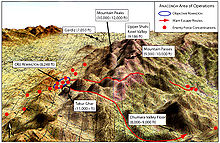This article needs additional citations for verification. (April 2010) |
| Battle of Takur Ghar | |||||||
|---|---|---|---|---|---|---|---|
| Part of Operation Anaconda during the War in Afghanistan | |||||||
| |||||||
| Belligerents | |||||||
|
|
| ||||||
| Commanders and leaders | |||||||
|
|
| ||||||
| Strength | |||||||
|
|
At least 10 at hilltop camp[3] Around 35 in reinforcement[4] | ||||||
| Casualties and losses | |||||||
|
7 killed 12 wounded 2 Chinooks lost | 25–200 killed[2] | ||||||

The Battle of Takur Ghar was a short but intense military engagement between United States special operations forces and al-Qaeda insurgents fought in March 2002, atop Takur Ghar mountain in Afghanistan. For the U.S. side, the battle proved the deadliest entanglement of Operation Anaconda, an effort early in the War in Afghanistan to rout al-Qaeda forces from the Shahi-Kot Valley and Arma Mountains. The battle saw three helicopter landings by the U.S. on the mountain top, each met with direct assault from al-Qaeda forces. Although Takur Ghar was eventually taken, seven U.S. service members were killed and 12 others were wounded. The battle is also known as the Battle of Roberts Ridge, after the first casualty of the battle, Navy SEAL Neil C. Roberts.
- ^ Naylor, Sean (1 June 2006). Not a Good Day to Die: The Untold Story of Operation Anaconda. Penguin Books Limited. pp. 46, 118–119. ISBN 978-0-14-192946-0.
- ^ a b MacPherson, Malcolm (July 25, 2006). Roberts Ridge: A Story of Courage and Sacrifice on Takur Ghar Mountain, Afghanistan. New York: Dell. p. 290. ISBN 978-0553586800.
- ^ MacPherson, Malcolm (July 25, 2006). Roberts Ridge: A Story of Courage and Sacrifice on Takur Ghar Mountain, Afghanistan. New York: Dell. p. 62. ISBN 978-0553586800.
- ^ MacPherson, Malcolm (July 25, 2006). Roberts Ridge: A Story of Courage and Sacrifice on Takur Ghar Mountain, Afghanistan. New York: Dell. p. 239. ISBN 978-0553586800.
